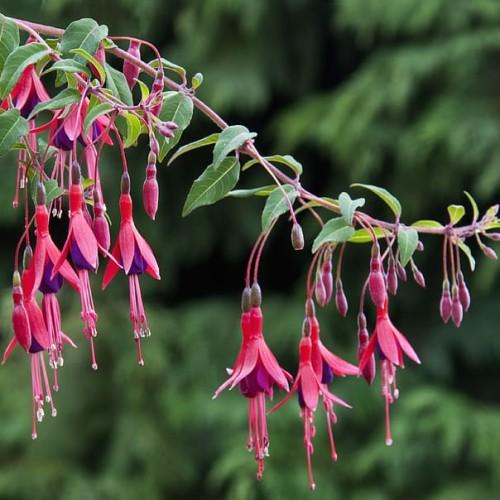
hardy fuchsia
Fuchsia magellanica var. macrostema 'Tricolor'
Also Known As - lady's eardropsCycle:
Perennial
Watering:
Average
Hardiness Zone:
7
Flowers:
Flowers In Summer
Sun:
part sun/part shade,full sun
Fruits:
Fruits In Autumn Ready In
Leaf:
Yes
Growth Rate:
Moderate
watering
Hardy fuchsia (Fuchsia magellanica var. macrostema 'Tricolor') should be watered deeply and regularly to ensure healthy growth. The best way to water this plant is to wait until the surface of the soil feels slightly dry to the touch before watering. During the warmer months, it's best practice to water at least once every 7-14 days. In the colder months, this should be cut back slightly to once every 14-21 days. Make sure you water it until the soil is thoroughly moistened, but be careful not to over-water it as it prefers well-draining soil and to be slightly dry between waterings.
sunlight
Hardy fuchsias do best in bright, indirect light exposure with between 3 and 4 hours of direct sunlight every day for optimal flowering. During the summer months, it is best to place the plant in a partially shaded area, as the full effect of the sun’s heat may cause the leaves of the fuchsia to scorch in too much direct sunlight. Indirect light from eastern or western windows are a great choice for showing off the ‘Tricolor’ variety of hardy fuchsia.
pruning
Hardy fuchsia (Fuchsia magellanica var. macrostema 'Tricolor') should be pruned lightly throughout the growing season, with more pruning in late winter or early spring. Pruning should be done to maintain the desired shape of the plant and to remove dead, damaged or overcrowded branches. Light pruning should be done in summer and autumn, when new growth is starting to appear. During the winter and spring months, prune back all growth to the desired length, being careful not to cut back too much. To promote bushier growth and flowering, pinch back new growth in the summer and autumn. Old stems can be cut back to the ground during the winter and spring for vigorous renewal and better overall health of the plant.
